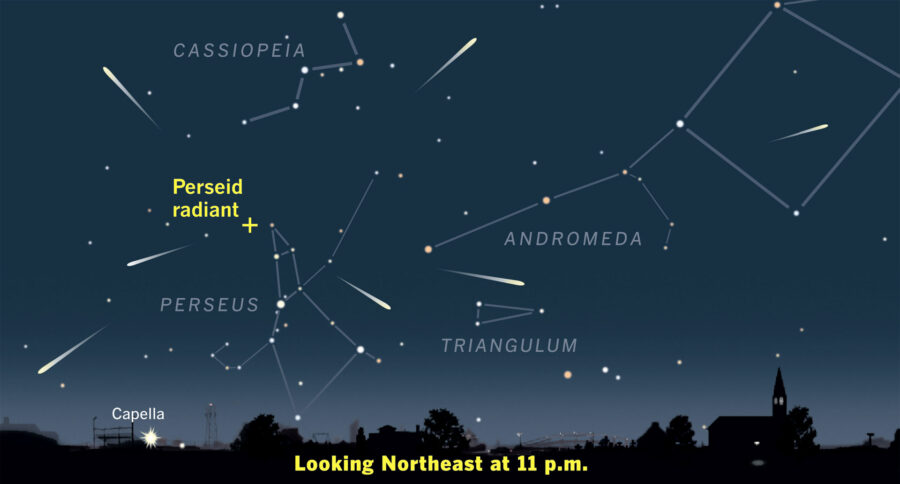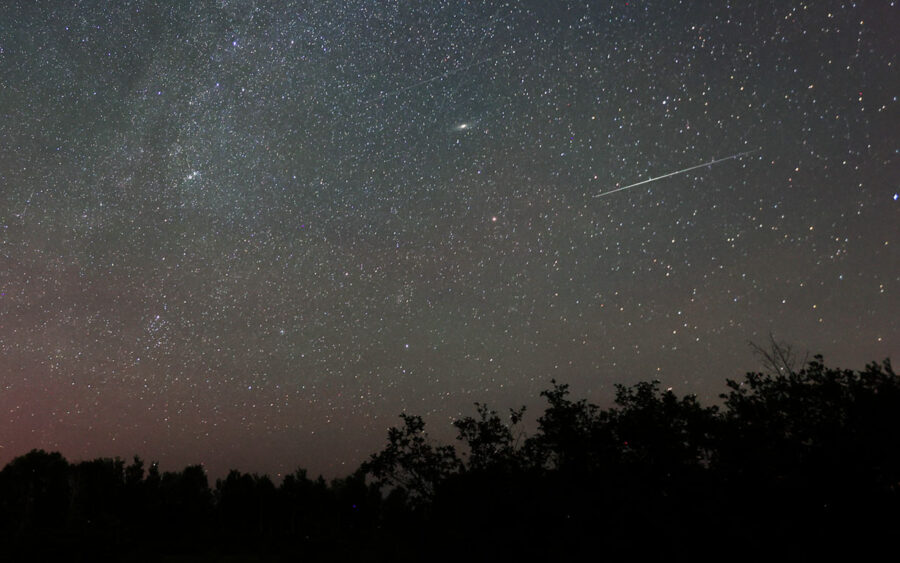The Perseids are here! With no Moon to spoil the show it’s time to break out the lawn chairs, sit back, and watch the comet dust fly.

Petr Horálek
The annual Perseid shower will make its big splash on the night of August 12–13. Patience has its reward. Observers won't have to tangle with the full Moon as we did last year. Instead, an 8%-illuminated crescent will rise around 3 a.m. local time and make a welcome sight in the eastern sky as dawn gets underway. Additionally, two potential meteor outbursts during and after shower maximum could sweeten the pot. More about those in a moment.
Perseids flare at the rate of about one a minute from a dark sky. If you're able and the weather looks ideal consider a drive to the countryside to fully appreciate the rich harvest of meteors in the offing. Invite family and friends to share the experience. Neither telescope nor binoculars are needed, just a reclining chair, snacks, and warm clothing in case you stay out late. This interactive light-pollution map will help you find the darkest skies near your home.

Sky & Telescope
Closer to town the number of visible meteors drops. Suburban observers will still get a good show but see about half as many. Either way this is definitely something worth keeping the kids up late to see. A single fireball witnessed by American meteoriticist Harvey Nininger in November 1923 forever changed his life. He abandoned his chosen field of biology to hunt for and study meteorites, eventually acquiring the world's largest private collection of space rocks. Who knows what a flaring Perseid might inspire in a young mind?
You can begin your meteor vigil around 10 p.m. local time at the end of evening twilight. Plan to spend at least an hour with the shower. Composite photos — compiled of many images taken over hours and sometimes days — give the impression that meteors fall like rain. Instead, they arrive piecemeal, either singly or in brief bursts, followed by down time until the next flash appears. Anticipating the arrival of the next spear of meteoric light is one of the Perseid's greatest pleasures. Embrace the gaps and you'll have a wonderful time.
Composite photos excel at revealing the shower's radiant — the starting point or "source" of the shower. All Perseids stream from a point in the constellation Perseus just below the eastern end of Cassiopeia's "W." This makes Perseids easy to distinguish from non-shower meteors called sporadics. Just trace a meteor trail backwards and if it points to Perseus you can be confident you've bagged a shower member. The later you stay up the more meteors you'll see because the radiant rises higher and higher through the night. Peak viewing time is between midnight and dawn on Sunday morning, August 13th. If untimely clouds appear try watching the night before or after when activity will still be at half-strength.
Perseids originate from Comet 109P/Swift-Tuttle, which was discovered by American astronomers Lewis Swift and Horace Tuttle in July 1862. The comet comes to perihelion every 133 years and is the largest near-Earth object to make repeated close approaches to Earth. During each visit to the inner solar system the Sun heats and vaporizes a portion of its dust-laden ice. Solar radiation pressure nudges the solid particles into the comet's wake, which spread out along its orbit like spilled bread crumbs. After thousands of these visits a broad ring of dust along the comet's orbital path is created. Earth crosses the orbit of 109P/Swift-Tuttle every August. Much as sand pelts your car windows when driving through a dust storm cometary meteoroids strike the atmosphere at high speed, heat up, and become the "falling stars" of the Perseid meteor shower.
The interactive diagram (above) from meteorshowers.org depicts the Earth crossing the debris trail of the comet. Scroll to zoom in and out or press your mouse button and drag to change the point of view. The blue dot represents Earth and the blue circle its orbit. Did you notice how steeply inclined (113°) the comet's orbit (and hence the Perseids) are to the plane of the solar system? The comet's dust stream intersects the plane of the solar system only in the neighborhood of Earth's orbit, making ours the sole planet to sample Comet 109P/Swift-Tuttle's bounty.
While the 26-kilometer-wide comet could really do some damage if it were to strike the Earth we're safe for now. Astronomers have determined that its orbit will remain stable for at least the next 2,000 years. Nor do we need fear its Perseid progeny, most of which consists of sand-size grains with some pea-to-walnut-size chunks mixed in. The bigger ones are responsible for the occasional Perseid fireball, meteors as bright or brighter than Venus. Like most comet solids the material is friable. You'll see this for yourself when some of the brighter Perseids fragment into pieces during their final plunge.
Each particle drills into the atmosphere at more than 133,000 miles per hour (59 km/s) some 100 kilometers overhead. Heat generated as the speeding debris compresses the air in its path creates a bright streak several kilometers long made of heated atoms ablated from the meteoroid, as well as a glowing trail of air molecules ionized by the impact. Meteor ionization trails reflect radio waves. If radio waves from a transmitter on the ground strike the trail perpendicularly the signal will return to the transmitter as a meteor echo. Scientists analyze these backscattered signals to learn about the object's mass, velocity, and trajectory.
If the radio waves bounce off at angles other than the perpendicular they're forward-scattered and can travel great distances, in some cases more than 2,000 kilometers. With the proper receiver you can tune into these eerie echoes. To hear the Perseids go to LiveMeteors.com on the peak night and listen for pings that resemble those from a submarine's sonar often depicted in movies.
Another way to keep tabs on the shower is to capture a fortuitous Perseid impact on the Moon by shooting video through a telescope. Crescent phase is ideal because much of the lunar nearside will be steeped in darkness, making for an ideal dark backdrop for spotting a flash. An analysis of 13 impact flashes detected on the Moon during the 2012 and 2013 Perseid meteor showers revealed some fascinating details about the material constituting the shower. José M. Madiedo (Universidad de Sevilla, Spain) and his team recorded impact glints ranging from magnitude 6.6 to 9.3, which correlated with meteoroids having masses between 190 grams and 9 grams. During the 2008 shower two amateurs on opposite sides of the U.S. each recorded an impact flash with 8-inch and 10-inch telescopes and video cameras.

Bob King
Due to the extended time it takes Earth to cross Comet 109P/Swift-Tuttle's orbit you'll casually see Perseids any clear night for a week centered on the date of maximum. The International Meteor Organization notes that on August 14 between 1 UT and 2:45 UT (August 13th, 9–10:45 p.m. Eastern Daylight Time) Earth will encounter a trail of dust (called a filament) released by the comet in 68 BCE that could briefly boost meteor counts. Another weaker filament crossing may occur on August 13 around 3 UT (August 12th at 11 p.m. Eastern).
If you're hit with bad weather this weekend use Windy.com and SpotWx to find a clear location. Both provide excellent cloud displays and graphics day or night. You'll also find detailed cloud forecasts on Clear Dark Sky and Astrospheric. If all those fail, Italian astrophysicist Gianluca Masi will livestream the shower starting at 1:30 UT on August 13th (9:30 p.m. Eastern on August 12th).
One way or another we want to make sure you see — or hear — the Perseids.
 1
1









Comments
Rod
August 14, 2023 at 8:34 am
I posted an observation note here from last night, https://skyandtelescope.org/astronomy-news/observing-news/this-weeks-sky-at-a-glance-august-11-20/
2 Perseid observed shortly after 2100 EDT. Some cirrus started moving in too.
You must be logged in to post a comment.
You must be logged in to post a comment.